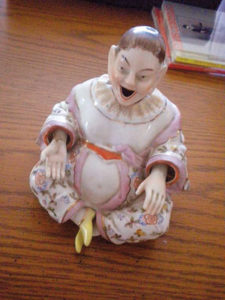
In the 21st century we know a nodder as “bobblehead,” or figurine, often in the form of characters or sports stars, with bobbing heads. But who will forget the famous nodders from the 20th century – LBJ’s beagles, “Him” and “Her,” and TV’s Dobie Gillis, for example.
I recently did an appraisal for a lady who inherited beautiful porcelain dating to the early 19th century. As often happens, a mother left this to a daughter who never found use for the gold-edged china services and regal sterling silver flatware. The daughter, now 85, plans to move to an elder care facility and wanted to give these elegant items away.
This aroused my curiosity. Where I see elegant things from the 19th century, I sometimes find something of value from the 18th century. What I found I wasn’t prepared for. On her dining table sat a “nodder.”
The Original Nodders
The original nodding head figures go back 2,000 years to religious figures, namely the deities of China. These often came as separate god heads attached to porcelain bodies wired with a weight to nod in the direction of the devotee. Sometimes in ancient China makers attached heads to a brass bell with a wire. A far cry from the 1920s nodding head pair of Hitler Youth, with their brown shirts and full-on salute.
Porcelain became known in China as early as the year 196 BC. That’s not a misprint. By this period, called the Han Dynasty, traders exported porcelain from China to the Islamic world. Hence, our modern-day word for porcelain we call China. Why did people in those days prize porcelain? First, the outside world saw the composition as a Chinese mystery. Europe didn’t discover the composition of porcelain until 1709, a technique discovered more than a thousand years after the Chinese discovered it. The secret involved a mixture of clay in the form of kaolin mixed, in part, with the mineral mullite and fired at a temperature of at least 2,552 degrees. This stuff was so durable it didn’t need glazing for water-proofing. Second, when glazed, they under-painted it with fine detail, and the light shone through it, unlike other types of ceramic.
Naturally the early porcelain factory in Meissen in Saxon in old Germany sent explorers abroad to China. They noticed these Chinese deities with the nodding heads and attempted to copy them in the 18th century, but with a twist. They didn’t call these early figurines with Asian features nodders. Rather, they called them pagodas because they exclusively represented Asians.
What I found on the daughter’s dining table
A rare 18th-century Meissen pagoda, possibly one of the earliest forms of porcelain known to the European world.
European high society coveted these early porcelain figures because they seemed animated. They nodded their heads via a suspended wire and weight, as well as sometimes moving their hands and feet at the same time. We see this as an early combination of high porcelain artistry and engineering. Why did Meissen and Dresden factories in the 18th century decide on this specific ethnicity for the figures? As I said before, the Chinese discovered the form as well as the chemical makeup of porcelain itself. Moreover, Europeans considered the wagging head an “Eastern” mannerism.
As you will notice in the photo that accompanies this post, the figurine is cross-legged on the floor with his arms balanced on his knees. No noble European would be seen in such a pose, and they automatically understood this pose as “Oriental.” While clearly politically incorrect now, back in the 18th century, they used it as shorthand for the comical old inscrutable “Oriental.” In keeping with such stereotyping these Asian-featured figurines also included large protruding ears, a big, gaping, laughing mouth, and hair finished in a topknot. These images persisted for 200 years during the period of porcelain novelty figurines.
These nodders did not just caricature Asians. Soon, they targeted African-Americans. These nodders were called “nodding off” nodders as they portrayed poor black folks as dozing off. Ouch!
What’s the nodder I found worth today?
Granted, one hand has a “loss” or break (which can be repaired – and should be – as this piece is rare). But this type of 10-inch figurine has shown up for auction in the recent past, garnering the following sales figures, even with some small repairs present: in 2011, two sales – $7,500 and $3,690; in 2008, $2,596; and in 2004, $3,290. So this was a real find!
Pingback: Pair of Standing Nodding Magots - Elizabeth Appraisals
Porcelain Factory “Von Schierholz” in Plaue, Thuringia, Germany